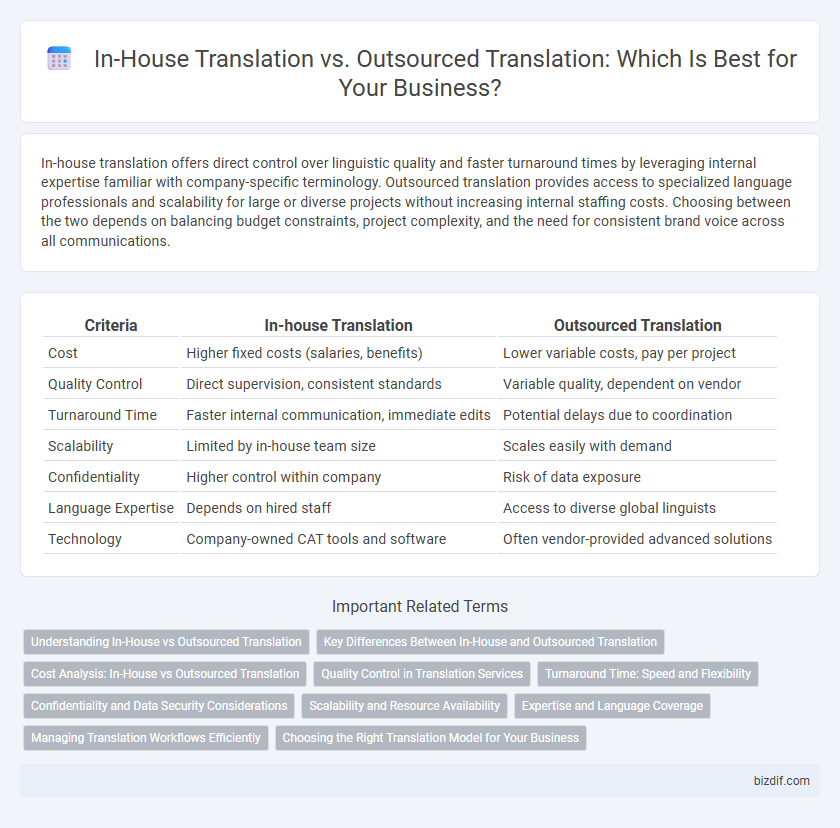In-house translation offers direct control over linguistic quality and faster turnaround times by leveraging internal expertise familiar with company-specific terminology. Outsourced translation provides access to specialized language professionals and scalability for large or diverse projects without increasing internal staffing costs. Choosing between the two depends on balancing budget constraints, project complexity, and the need for consistent brand voice across all communications.
Table of Comparison
| Criteria | In-house Translation | Outsourced Translation |
|---|---|---|
| Cost | Higher fixed costs (salaries, benefits) | Lower variable costs, pay per project |
| Quality Control | Direct supervision, consistent standards | Variable quality, dependent on vendor |
| Turnaround Time | Faster internal communication, immediate edits | Potential delays due to coordination |
| Scalability | Limited by in-house team size | Scales easily with demand |
| Confidentiality | Higher control within company | Risk of data exposure |
| Language Expertise | Depends on hired staff | Access to diverse global linguists |
| Technology | Company-owned CAT tools and software | Often vendor-provided advanced solutions |
Understanding In-House vs Outsourced Translation
In-house translation involves utilizing a dedicated team of translators within a company, ensuring greater control, confidentiality, and consistent brand voice across all content. Outsourced translation leverages external agencies or freelancers, offering access to diverse language expertise and scalability for large or specialized projects. Understanding the trade-offs between these approaches helps organizations balance cost, quality, flexibility, and turnaround time.
Key Differences Between In-House and Outsourced Translation
In-house translation offers greater control over the translation process, ensuring consistent brand voice and immediate collaboration with subject matter experts, while outsourced translation provides access to a diverse pool of specialized linguists and often reduces operational costs. In-house teams excel in confidentiality and quick turnaround for urgent projects, whereas outsourced services leverage advanced localization technologies and scalability to manage large volumes efficiently. Choosing between in-house and outsourced translation depends on factors like project complexity, budget constraints, and the need for linguistic and cultural expertise.
Cost Analysis: In-House vs Outsourced Translation
In-house translation typically involves fixed costs such as salaries, benefits, and training for dedicated translators, which can be cost-effective for large volumes or ongoing projects. Outsourced translation offers variable pricing, where costs depend on project size, language pair, and complexity, often resulting in lower expenses for smaller or sporadic assignments. Companies must evaluate the balance between fixed overhead and per-project fees to optimize their translation budget while maintaining quality.
Quality Control in Translation Services
In-house translation teams offer direct oversight and consistent quality control through close collaboration and immediate feedback loops, ensuring adherence to brand voice and style guidelines. Outsourced translation services rely on established vendor processes and technology-driven quality assurance tools, which can vary in effectiveness depending on the provider's expertise and project management. Maintaining high-quality translation requires rigorous reviews, standardized terminology databases, and continuous communication regardless of whether the work is done internally or externally.
Turnaround Time: Speed and Flexibility
In-house translation teams often provide faster turnaround times due to direct communication and immediate access to project materials, enabling quick adjustments and real-time collaboration. Outsourced translation services offer greater flexibility by scaling resources to meet varying workload demands, effectively managing peak periods without compromising speed. Both methods balance speed and flexibility differently, with in-house teams excelling in rapid, customized workflows and outsourced providers optimizing resource allocation for larger, fluctuating projects.
Confidentiality and Data Security Considerations
In-house translation teams offer enhanced confidentiality and tighter control over sensitive data by limiting access to internal staff and utilizing secure company systems, reducing the risk of information leaks. Outsourced translation services require thorough vetting of providers' data security protocols, including compliance with standards like ISO 27001 and use of encrypted file transfers, to safeguard proprietary content. Organizations handling critical or proprietary information must evaluate these factors carefully to mitigate risks associated with data breaches during the translation process.
Scalability and Resource Availability
In-house translation teams offer consistent quality control but often face limitations in scalability and resource availability during peak workloads or large projects. Outsourced translation services provide flexible scalability by leveraging a vast network of linguists across multiple languages and specialties, ensuring rapid turnaround and access to rare language pairs. Businesses seeking efficient scalability and diverse linguistic resources typically benefit from outsourced solutions that adapt to fluctuating project demands without compromising deadlines.
Expertise and Language Coverage
In-house translation teams offer specialized expertise tailored to specific industry needs, ensuring consistent terminology and brand voice across projects. Outsourced translation services provide access to a broader range of language coverage and diverse linguistic experts, ideal for multinational organizations requiring rapid scalability. Companies must evaluate language complexity and project scope to determine the optimal balance between in-house proficiency and outsourced flexibility.
Managing Translation Workflows Efficiently
Managing translation workflows efficiently involves balancing control and scalability; in-house translation teams offer direct oversight and immediate communication, streamlining project coordination. Outsourced translation services provide access to specialized linguistic expertise and can scale rapidly to meet fluctuating demands without the overhead of maintaining permanent staff. Leveraging translation management systems integrates both approaches, optimizing resource allocation and ensuring consistent quality across multilingual projects.
Choosing the Right Translation Model for Your Business
Selecting the appropriate translation model for your business hinges on factors like budget, turnaround time, and control over quality. In-house translation offers greater consistency and confidentiality, ideal for companies needing tight integration with internal teams and brand messaging. Outsourced translation provides scalability and access to a diverse language pool, making it suitable for businesses with fluctuating translation demand or complex multilingual projects.
In-house Translation vs Outsourced Translation Infographic

 bizdif.com
bizdif.com